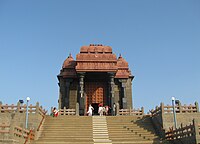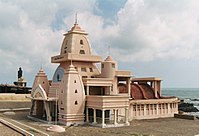Kanyakumari - The Travel Guide
Kanyakumari - The Travel Guide


OverView:
Kanyakumari is a coastal town in the state of Tamil Nadu on India's southern tip. Jutting into the Laccadive Sea, the town was known as Cape Comorin during British rule and is popular for watching sunrise and sunset over the ocean. It's also a noted pilgrimage site thanks to its Bagavathi Amman Temple, dedicated to a consort of Shiva, and its Our Lady of Ransom Church, a center of Indian Catholicism.
Kanyakumari pronunciation , also known as Kanniyakumari, formerly known as Cape Comorin, is a town in Kanyakumari District in the state of Tamil Nadu in India. The name comes from the Devi Kanya Kumari Temple in the region. It is the southernmost tip of peninsular India. Kanyakumari town is the southern tip of the Cardamom Hills, an extension of the Western Ghats range. The nearest town is Nagercoil, the administrative headquarters of Kanyakumari District, 22 km (14 mi) away. Kanyakumari has been a town since Sangam period[1][2] and is a popular tourist destination.[3]
pronunciation , also known as Kanniyakumari, formerly known as Cape Comorin, is a town in Kanyakumari District in the state of Tamil Nadu in India. The name comes from the Devi Kanya Kumari Temple in the region. It is the southernmost tip of peninsular India. Kanyakumari town is the southern tip of the Cardamom Hills, an extension of the Western Ghats range. The nearest town is Nagercoil, the administrative headquarters of Kanyakumari District, 22 km (14 mi) away. Kanyakumari has been a town since Sangam period[1][2] and is a popular tourist destination.[3]
Offshore, the Vivekananda Rock Memorial sits on a tiny island steeped in ancient legends, with a fortlike structure dedicated to Hindu monk Swami Vivekananda. Another island is home to the colossal Thiruvalluvar Statue, adorned with elephant statues at its base. It was built to honor the Tamil poet, philosopher and author of "Thirukkural", an important work of Tamil literature. The Tsunami Monument commemorates the victims of the 2004 Indian Ocean tsunami. Nearby is Gandhi Mandapam, built in the style of an Orissan Sun Temple, which marks the spot where Gandhi's ashes were kept in an urn before being scattered in the ocean in 1948.











OverView:
Kanyakumari is a coastal town in the state of Tamil Nadu on India's southern tip. Jutting into the Laccadive Sea, the town was known as Cape Comorin during British rule and is popular for watching sunrise and sunset over the ocean. It's also a noted pilgrimage site thanks to its Bagavathi Amman Temple, dedicated to a consort of Shiva, and its Our Lady of Ransom Church, a center of Indian Catholicism.
Kanyakumari
Offshore, the Vivekananda Rock Memorial sits on a tiny island steeped in ancient legends, with a fortlike structure dedicated to Hindu monk Swami Vivekananda. Another island is home to the colossal Thiruvalluvar Statue, adorned with elephant statues at its base. It was built to honor the Tamil poet, philosopher and author of "Thirukkural", an important work of Tamil literature. The Tsunami Monument commemorates the victims of the 2004 Indian Ocean tsunami. Nearby is Gandhi Mandapam, built in the style of an Orissan Sun Temple, which marks the spot where Gandhi's ashes were kept in an urn before being scattered in the ocean in 1948.

Tourism:
This area is very beautiful. Since the early 1970s, tourism has been an industry in the town. Because of this it is one of the few small towns in South India where one can hear many of the different languages of India spoken in the street.
Of late, the promotion of tourism has increased, with increasing emphasis on attractions outside the town, such as the surrounding landscapes, as well as the historical and religious sites found around the district. Ultimately a total of 1.9 million tourists (domestic and foreign) visited Kanyakumari in 2007.[9]
Though there are several places of tourist-interest in the town and district, Kanyakumari is especially popular in India for its spectacular and unique sunrise and sunset, thanks to its being nearly surrounded by waters. On balmy, full-moon evenings (locally called Chitra Pournami), one can also see the moon-rise and sunset at the same time.

Transport ways - By road, By Train🚂 and By flight.
(By Road - have almost from all cities in India have direct connected transportation by road.)
(By Train - Important Trains :
- 12641/Thirukkural Express
- 12665/Howrah - Kanyakumari SF Express (Weekly)
- 22621/Rameswaram - Kanyakumari SF Express
- 16861/Pondicherry- Kanyakumari Express (Weekly)
- Chennai Egmore - Kanniya Kumari SF Express|12633/Chennai Egmore - Kanniya Kumari SF Express)

Information about Kanyakumari History and Places you can visit:
Thiruvalluvar Statue

The Thiruvalluvar Statue has a height of 95 feet (29 m) and stands upon a 38 foot (11.5 m) rock that represents the 38 chapters of "virtue" in the Thirukkural. The statue standing on the rock represents "wealth" and "pleasures", signifying that wealth and love be earned and enjoyed on the foundation of solid virtue.[12] The combined height of the statue and pedestal is 133 feet (40.5 m), denoting the 133 chapters in the Thirukkural. It has a total weight of 7000 tons.The statue, with its slight bend around the waist is reminiscent of a dancing pose of the ancient Indian deities like Nataraja. It was sculpted by the Indian sculptor Dr. V. Ganapati Sthapati, who also created the Iraivan Temple. Its opening ceremony was on 1 January 2000. The monument was hit by the Indian Ocean Tsunami on 26 December 2004.[13]
Vivekananda Rock Memorial

The Vivekananda Rock Memorial is a popular tourist monument in Vavathurai, Kanyakumari, India. The memorial stands on one of two rocks located about 500 metres east of the mainland of Vavathurai, India's southernmost tip. It was built in 1970 in honour of Swami Vivekananda who is said to have attained enlightenment on the rock.[1] According to local legends, it was on this rock that Goddess Kumari performed austerity. A meditation hall (Dhyana Mandapam) is also attached to the memorial for visitors to meditate. The design of the mandapa incorporates different styles of temple architecture from all over India. It houses a statue of Vivekananda. The rocks are surrounded by the Laccadive Sea. The memorial consists of two main structures, the Vivekananda Mandapam and the Shripada Mandapam.[3]
Gandhi Memorial Mandapam

The Gandhi Memorial Mandapam has been built on the spot where the urn containing the Mahatma's ashes was kept for public viewing before immersion. Resembling central Indian Hindu temples in form, the memorial was designed in such a way that on Mahatma Gandhi's birthday, 2 October, the first rays of the sun fall on the exact place where his ashes were kept.[3]
Tsunami Memorial Park

Near Kanyakumari's southern shore stands a monument to the memory of those who died in the 2004 Indian Ocean earthquake and tsunami, an underwater megathrust earthquake that claimed around 280 000 lives in many countries, including India, Sri Lanka, Somalia, Thailand, Maldives and Indonesia. People from places near and far visit this monument to pay homage to all those who lost their lives.
Bhagavathy Amman Temple

Bhagavathy Amman Temple is a 3000-year-old temple dedicated to Goddess Kumari Amman located at Kanyakumari. Kumari Amman is one of the form of Devi, popularly known as “Kumari Bhagavathy Amman”. Kumari Bhagavathy Amman temple is the first Durga temple created by Lord Parasurama and one of the 108 Shakthi Peethas. This temple is situated at the shore of the Laccadive Sea. Kumari temple has been mentioned in Ramayana, Mahabarata and Purananooru.[14]
Ayya Vaikundar Nizhal Thangal

Ayya Vaikundar Nizhal Thangal is a beautiful shrine dedicated to Ayya Vaikundar in Attoor, a small hamlet in Kanyakumari. It is revered shrine for followers of Ayyavazhi, who believe that Ayya Vaikundar is an avatar or incarnation of Lord Narayana. Ayyavazhi, a dharmic belief system, is based on the teachings and life history of Ayya Vaikundar.The highlight of this place is its unique architectural style - Sahasrara (literal meaning white lotus). Historians believe that it is the first temple to boast Sahasrara architecture. Originally, this structure was built in 1988; however, it was reconstructed and inaugurated in the year 2007. The foundation stone of the new thangal was laid in 2005 by the present religious leader of Ayyavazhi - Bala Prajapathi Adikalar.
Kamarajar Mani Mantapa Monument
Kamarajar Mani Mantapa Monument was raised and dedicated to a freedom fighter and Former Chief minister of Tamil Nadu, President of Indian National Congress, Mr Kamarajar. He's also popularly known as Black Gandhi among the masses. Like the Gandhi Mantapa, this place is where Kamarajar's ashes were kept for the public to pay homage before immersion into the sea.[15]
Padmanabhapuram Palace
This granite palace is a fortress and was the residence of the Travancore rulers. It was constructed around 1601 AD. This palace also has a small museum that contains various artifacts from the older times.[16]
Thanks for Reading and Please like and share this page.!!!



Comments
Post a Comment
Thanks for your feedback